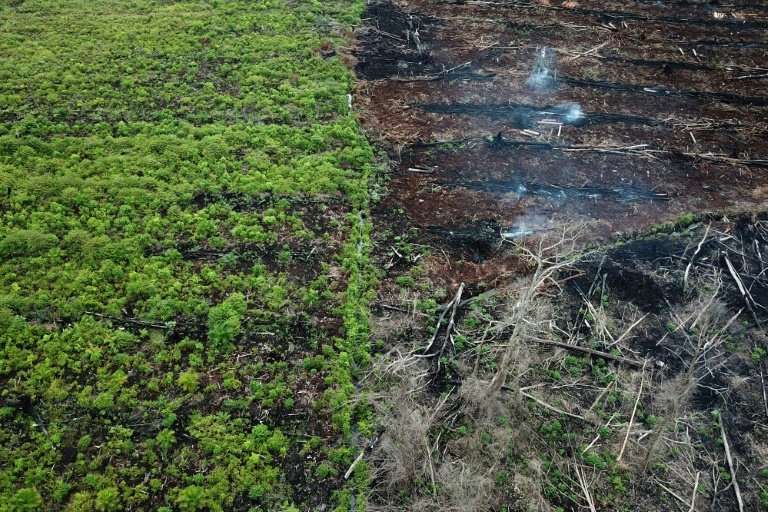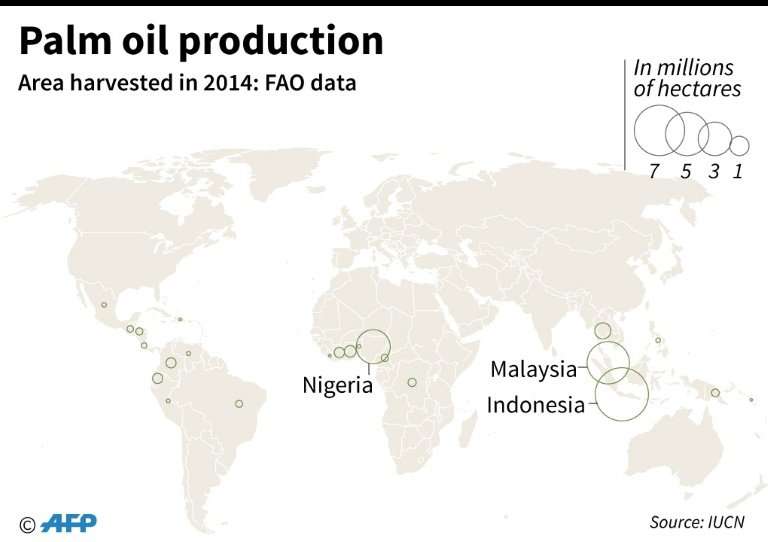Palm oil 'decimating' wildlife, solutions elusive: report

Palm oil production has "decimated" animal and plant life in Malaysia and Indonesia, and threatens pristine forests in central Africa and South America, a leading international conservation group warned Tuesday.
Habitat loss due to expanding plantations has pushed some of the planet's most iconic species—including orangutans, tigers and some gibbons—to the brink of extinction, the International Union for the Conservation for Nature (IUCN) concluded in a report.
"Palm oil is decimating Southeast Asia's rich diversity of species as it eats into swathes of tropical forest," said lead author Erik Meijaard, head of the organisation's Oil Palm Task Force.
But banning new production in the tropics would only shift the problem elsewhere as consumer demand for vegetable oil soars, the report cautioned.
"When you consider the disastrous impacts of palm oil on biodiversity from a global perspective, there are no simple solutions," said IUCN Director General Inger Andersen.
"Half the world's population uses palm oil in food, and if we ban or boycott it, other more land-hungry oils will likely take its place."
Rapeseed, soy and sunflowers require up to nine times as much land to produce an equivalent amount of oil.
All told, 193 animals and plants threatened with extinction on the IUCN's Red List of endangered species were found to have been harmed by the cash crop.
Monoculture palm oil plantations sustain only a small fraction of the plant and animal life found in the tropical forests they supplant.
In Borneo—the world's largest palm oil producing region, with 8.3 million hectares planted at of 2016—half the rainforests lost from 2005 to 2015 were destroyed by palm oil development.
In the area under Malaysian rule, it was responsible for nearly 60 percent of deforestation between 1973 and 2015.
Worldwide, palm oil plantations—three-quarters of them industrial-scale—cover 250,000 square kilometres, an area roughly the size of Italy or the US state of Arizona.

Palm oil on degraded lands
More than 90 percent of current production is in Indonesia and Malaysia, but plantations are expanding rapidly in central Africa and parts of Latin America as well.
"Because palm oil is grown in the species-rich tropics, this could have catastrophic effects on global biodiversity," the authors warned.
Areas into which the crop is poised to expand are home to more than half the world's threatened mammals, and two-thirds of threatened birds.
Oil palms, native to western Africa, produce 35 percent of the world's vegetable oil, most of which is consumed in India, China and Indonesia.
Three-quarters of all palm oil is used for food or cooking oil, with the rest found in cosmetics, cleaning products and biofuels.
In 2017, more than half of palm oil used in Europe ended up in the gas tanks of cars and trucks, according Transport & Environment, a Brussels-based environmental watchdog group.
One solution promoted by environmentalists is to shift production away from intact tropical forest.
"There are three million hectares of degraded land in Kalimantan," the Indonesian portion of Borneo, noted Andrew Steer, President and CEO of the World Resources Institute in Washington D.C.
"Palm oil plantations are not evil in themselves—the issue is where they have been put," he told AFP.
"If they are located on these degraded lands rather than pristine forests, it will also help the climate and local economies."
Palm oil development contributes to climate change and pollution when deliberate forest-clearing fires release CO2 into the atmosphere and lung-clogging smog into the region's air. The process can foul local water supplies as well.
A 2016 study in Environmental Research Letters found that tropical forest fires set the previous year caused more than 90,000 premature deaths in Indonesia, and several thousand more in neighbouring Singapore and Malaysia.
Journal information: Environmental Research Letters
© 2018 AFP



















